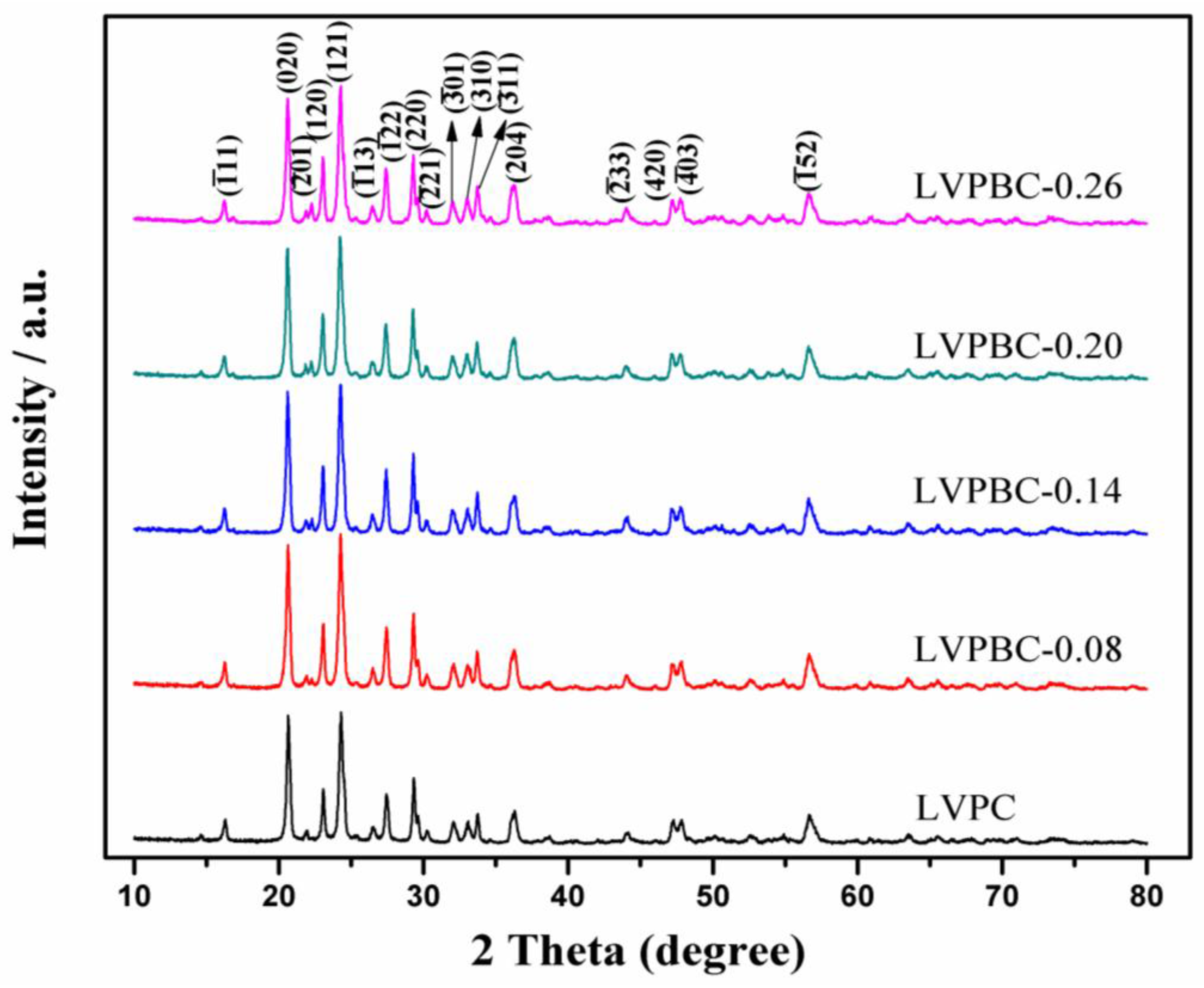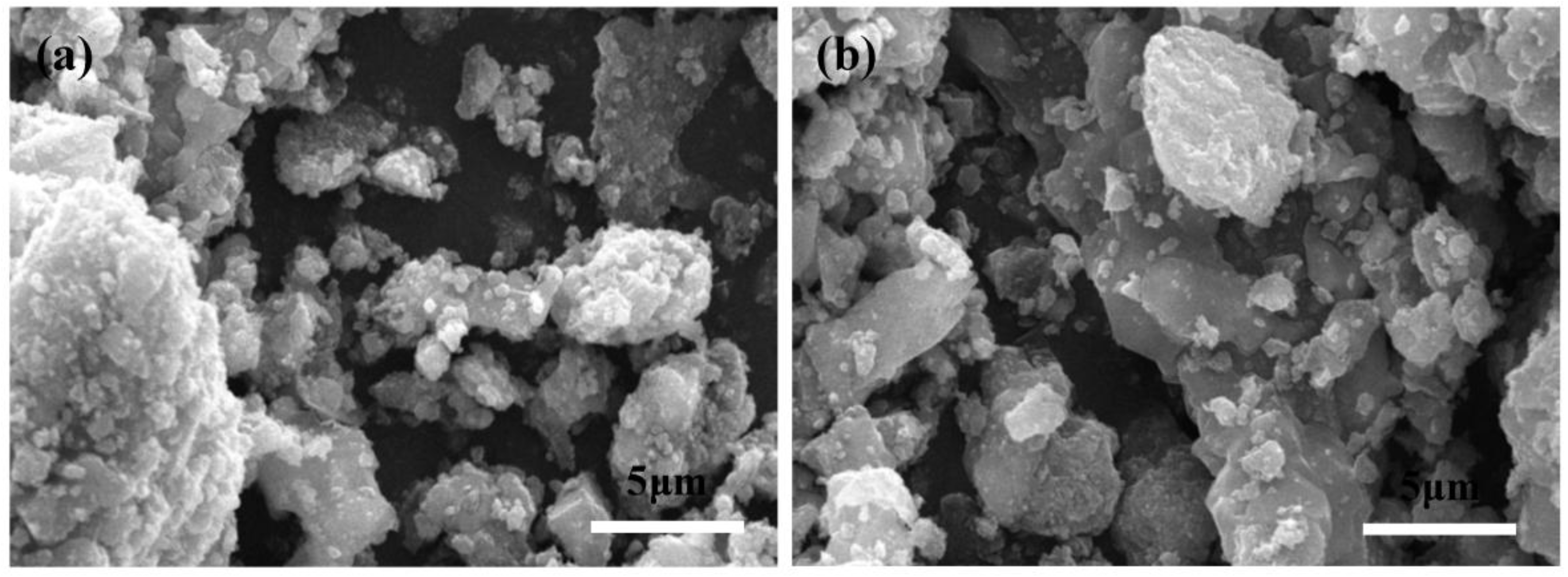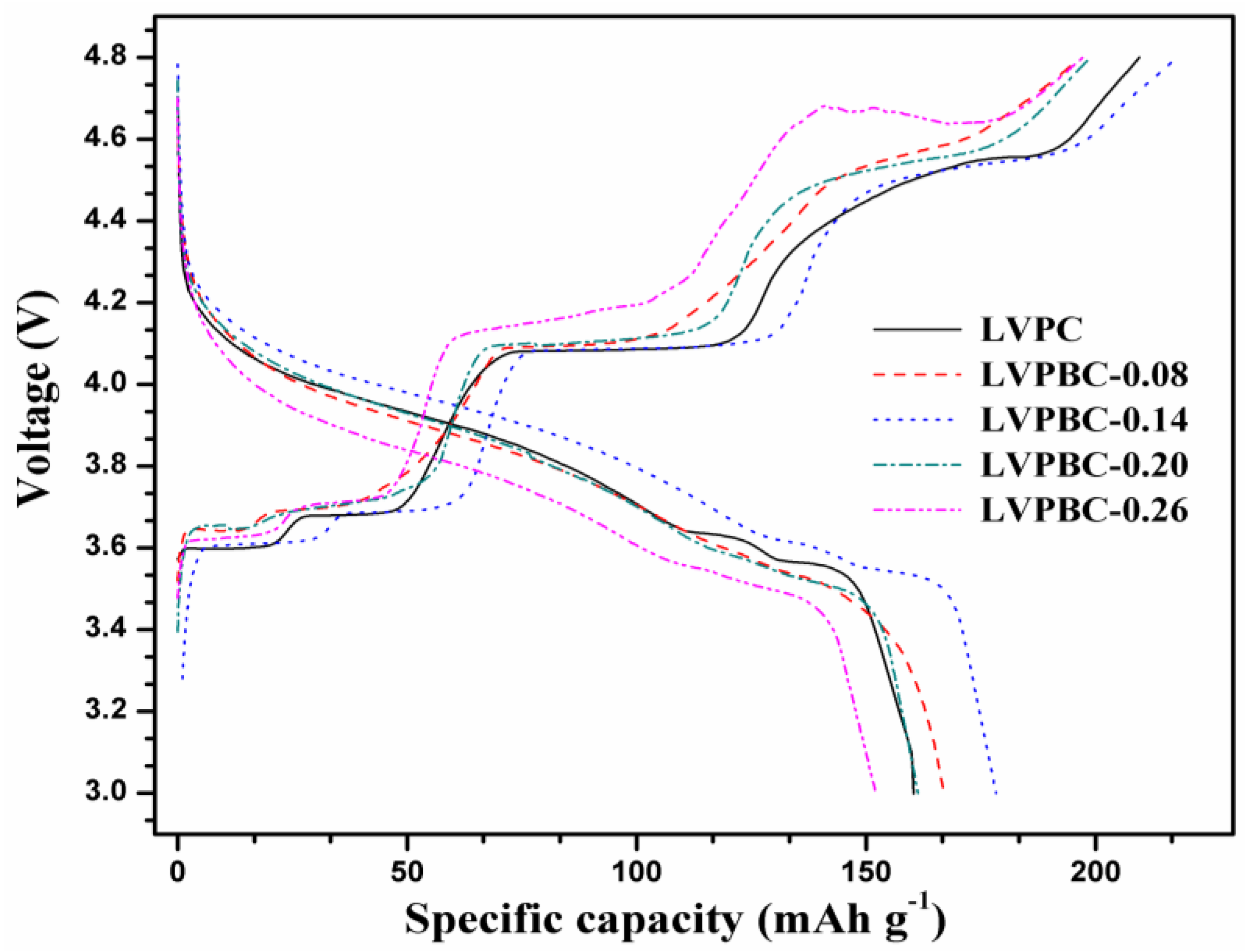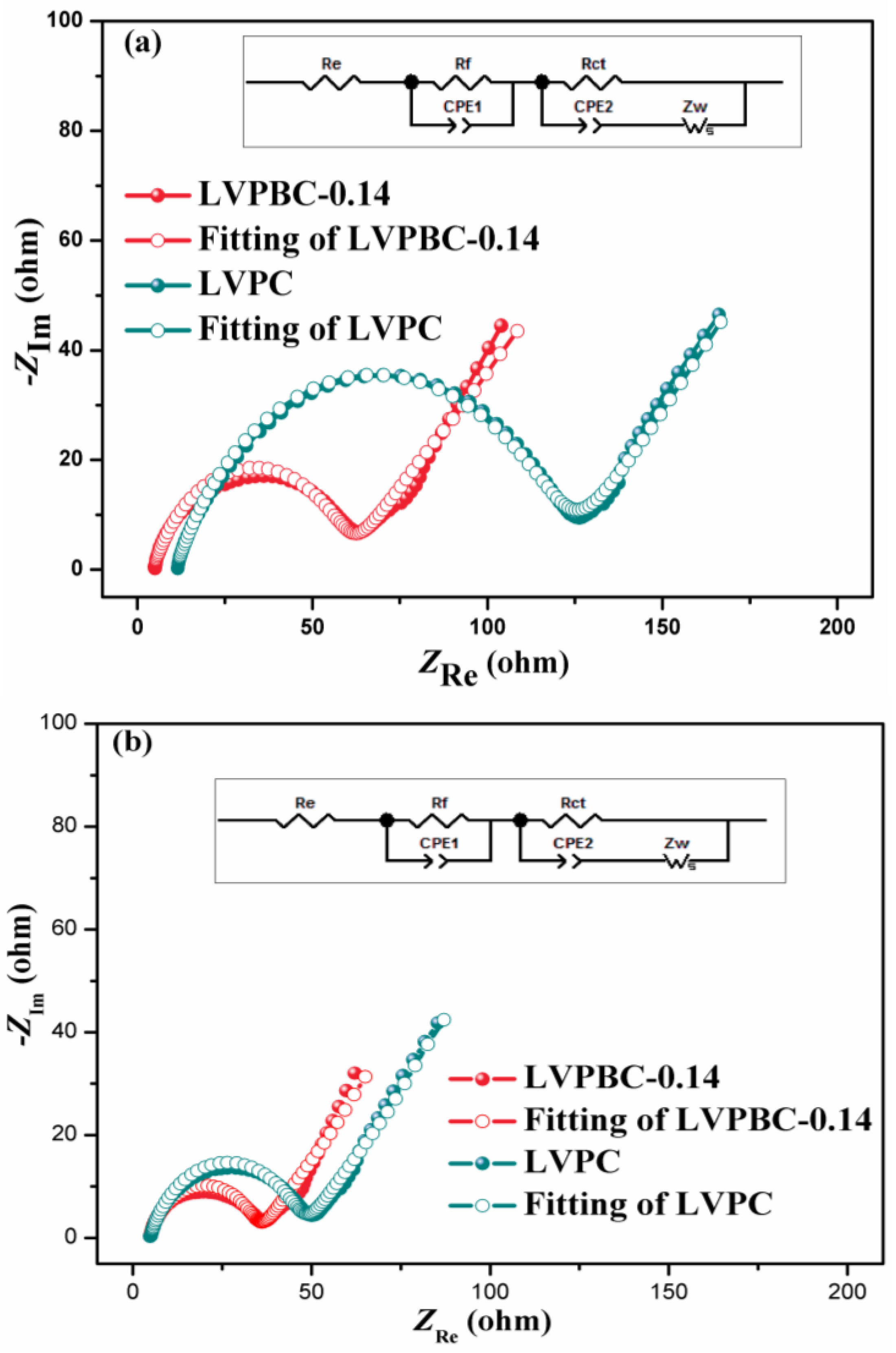Preparation and Electrochemical Properties of Li3V2(PO4)3−xBrx/Carbon Composites as Cathode Materials for Lithium-Ion Batteries
Abstract
:1. Introduction
2. Experimental
3. Results and Discussion
4. Conclusions
Acknowledgments
Author Contributions
Conflicts of Interest
References
- Daniel, C. Materials and processing for lithium-ion batteries. JOM 2008, 60, 43–48. [Google Scholar] [CrossRef]
- Shukla, A.K.; Kumar, T.P. Materials for next-generation lithium batteries. Curr. Sci. 2008, 94, 314–331. [Google Scholar]
- Li, J.L.; Daniel, C.; Wood, D. Materials processing for lithium-ion batteries. J. Power Sources 2011, 196, 2452–2460. [Google Scholar] [CrossRef]
- Li, H.; Wang, Z.X.; Chen, L.Q.; Huang, X.J. Research on advanced materials for Li-ion batteries. Adv. Mater. 2009, 21, 4593–4607. [Google Scholar] [CrossRef]
- Jaguemont, J.; Boulon, L.; Dube, Y. A comprehensive review of lithium-ion batteries used in hybrid and electric vehicles at cold temperatures. Appl. Energ. 2016, 164, 99–114. [Google Scholar] [CrossRef]
- Fergus, J.W. Recent developments in cathode materials for lithium ion batteries. J. Power Sources 2010, 195, 939–954. [Google Scholar] [CrossRef]
- Farmann, A.; Sauer, D.U. A comprehensive review of on-board State-of-Available-Power prediction techniques for lithium-ion batteries in electric vehicles. J. Power Sources 2016, 329, 123–137. [Google Scholar] [CrossRef]
- Kulova, T.L.; Skundin, A.M. High-voltage materials for positive electrodes of lithium ion batteries (review). Russ. J. Electrochem. 2016, 52, 501–524. [Google Scholar] [CrossRef]
- Xu, S.; Lu, L.; Jiang, X.; Luo, Z.; Liu, K.; Li, G.; Wang, S.; Feng, C. Y-doped Li3V2(PO4)3/C as cathode material for lithium-ion batteries. J. Appl. Electrochem. 2016, 46, 279–287. [Google Scholar] [CrossRef]
- Yang, Y.; Xu, W.; Guo, R.; Liu, L.; Wang, S.; Xie, D.; Wan, Y. Synthesis and electrochemical properties of Zn-doped, carbon coated lithium vanadium phosphate cathode materials for lithium-ion batteries. J. Power Sources 2014, 269, 15–23. [Google Scholar] [CrossRef]
- Rui, X.; Yan, Q.; Skyllas-Kazacos, M.; Lim, T.M. Li3V2(PO4)3 cathode materials for lithium-ion batteries: A review. J. Power Sources 2014, 258, 19–38. [Google Scholar] [CrossRef]
- Hu, M.; Pang, X.; Zhou, Z. Recent progress in high-voltage lithium ion batteries. J. Power Sources 2013, 237, 229–242. [Google Scholar] [CrossRef]
- Kim, S.; Zhang, Z.; Wang, S.; Yang, L.; Cairns, E.J.; Penner-Hahn, J.E.; Deb, A. Electrochemical and structural investigation of the mechanism of irreversibility in Li3V2(PO4)3 cathodes. J. Phys. Chem. C 2016, 120, 7005–7012. [Google Scholar] [CrossRef]
- Mateyshina, Y.G.; Uvarov, N.F. Electrochemical behavior of Li3−xM′xV2−yM″y(PO4)3 (M′=K, M″=Sc, Mg+Ti)/C composite cathode material for lithium-ion batteries. J. Power Sources 2011, 196, 1494–1497. [Google Scholar] [CrossRef]
- Zhang, L.L.; Liang, G.; Peng, G.; Huang, Y.H.; Wang, L.; Qie, L.; Croft, M.C.; Ignatov, A.; Goodenough, J.B. Insight into Fe incorporation in Li3V2(PO4)3/C cathode material. J. Electrochem. Soc. 2012, 159, A1573–A1578. [Google Scholar] [CrossRef]
- Yao, J.; Wei, S.; Zhang, P.; Shen, C.; Aguey-Zinsou, K.F.; Wang, L. Synthesis and properties of Li3V2−xCex(PO4)3/C cathode materials for Li-ion batteries. J. Alloys Compd. 2012, 532, 49–54. [Google Scholar] [CrossRef]
- Zhang, B.; Liu, J.Q.; Zhang, Q.; Li, Y.H. Electrochemical performance of Al-substituted Li3V2(PO4)3 cathode materials synthesized by sol-gel method. Trans. Nonferrous Met. Soc. China. 2010, 20, 619–623. [Google Scholar] [CrossRef]
- Yan, J.; Yuan, W.; Xie, H.; Tang, Z.Y.; Mao, W.F.; Ma, L. Novel self-catalyzed sol–gel synthesis of high-rate cathode Li3V2(PO4)3/C for lithium ion batteries. Mater. Lett. 2012, 71, 1–3. [Google Scholar] [CrossRef]
- Wang, L.; Tang, Z.; Ma, L.; Zhang, X. High-rate cathode based on Li3V2(PO4)3/C composite material prepared via a glycine-assisted sol–gel method. Electrochem. Commun. 2011, 13, 1233–1235. [Google Scholar] [CrossRef]
- Qiao, Y.Q.; Wang, X.L.; Xiang, J.Y.; Zhang, D.; Liu, W.L.; Tu, J.P. Electrochemical performance of Li3V2(PO4)3/C cathode materials using stearic acid as a carbon source. Electrochim. Acta 2011, 56, 2269–2275. [Google Scholar] [CrossRef]
- Han, H.; Qiu, F.; Liu, Z.; Han, X.E. ZrO2-coated Li3V2(PO4)3/C nanocomposite: A high-voltage cathode for rechargeable lithium-ion batteries with remarkable cycling performance. Ceram. Int. 2015, 41, 8779–8784. [Google Scholar] [CrossRef]
- Zhang, R.; Zhang, Y.; Zhu, K.; Du, F.; Fu, Q.; Yang, X.; Wang, Y.; Bie, X.; Chen, G.; Wei, Y. Carbon and RuO2 binary surface coating for the Li3V2(PO4)3 cathode material for lithium-ion batteries. ACS Appl. Mater. Inter. 2014, 6, 12523–12530. [Google Scholar] [CrossRef] [PubMed]
- Cai, G.; Yang, Y.; Guo, R.; Zhang, C.; Wu, C.; Guo, W.; Liu, Z.; Wan, Y.; Jiang, H. Synthesis and low temperature electrochemical properties of CeO2 and C co-modified Li3V2(PO4)3 cathode materials for lithium-ion batteries. Electrochim. Acta 2015, 174, 1131–1140. [Google Scholar] [CrossRef]
- Sun, C.; Rajasekhara, S.; Dong, Y.; Goodenough, J.B. Hydrothermal synthesis and electrochemical properties of Li3V2(PO4)3/C-based composites for lithium-ion batteries. ACS Appl. Mater. Inter. 2011, 3, 3772–3776. [Google Scholar] [CrossRef] [PubMed]
- Yan, J.; Mao, W.F.; Xie, H.; Tang, Z.Y.; Yuan, W.; Chen, X.C.; Xu, Q.; Ma, L. Microwave-assisted preparation of Li3V2(PO4)3/C composite with high-rate capacity. Mater. Res. Bull. 2012, 47, 1609–1612. [Google Scholar] [CrossRef]
- Pan, A.; Choi, D.; Zhang, J.G.; Liang, S.; Cao, G.; Nie, Z.; Arey, B.W.; Liu, J. High-rate cathodes based on Li3V2(PO4)3 nanobelts prepared via surfactant-assisted fabrication. J. Power Sources 2011, 196, 3646–3649. [Google Scholar] [CrossRef]
- Wang, X.Y.; Yin, S.Y.; Zhang, K.L.; Zhang, Y.X. Preparation and characteristic of spherical Li3V2(PO4)3. J. Alloys Compd. 2009, 486, L5–L7. [Google Scholar] [CrossRef]
- Liu, H.; Cheng, C.; Huang, X.; Li, J. Hydrothermal synthesis and rate capacity studies of Li3V2(PO4)3 nanorods as cathode material for lithium-ion batteries. Electrochim. Acta 2010, 55, 8461–8465. [Google Scholar] [CrossRef]
- Dai, C.; Chen, Z.; Jin, H.; Hu, X. Synthesis and performance of Li3(V1−xMgx)2(PO4)3 cathode materials. J. Power Sources 2010, 195, 5775–5779. [Google Scholar] [CrossRef]
- Ren, M.; Zhou, Z.; Li, Y.; Gao, X.P.; Yan, J. Preparation and electrochemical studies of Fe-doped Li3V2(PO4)3 cathode materials for lithium-ion batteries. J. Power Sources 2006, 162, 1357–1362. [Google Scholar] [CrossRef]
- Chen, Y.; Zhao, Y.; An, X.; Liu, J.; Dong, Y.; Chen, L. Preparation and electrochemical performance studies on Cr-doped Li3V2(PO4)3 as cathode materials for lithium-ion batteries. Electrochim. Acta 2009, 54, 5844–5850. [Google Scholar] [CrossRef]
- Kuang, Q.; Zhao, Y.; An, X.; Liu, J.; Dong, Y.; Chen, L. Synthesis and electrochemical properties of Co-doped Li3V2(PO4)3 cathode materials for lithium-ion batteries. Electrochim. Acta 2010, 55, 1575–1581. [Google Scholar] [CrossRef]
- Yang, Z.; Hu, J.; Chen, Z.; Zhong, J.; Gu, N.; Zhang, N. Sol–gel-assisted, fast and low-temperature synthesis of La-doped Li3V2(PO4)3/C cathode materials for lithium-ion batteries. RSC Adv. 2015, 5, 17924–17930. [Google Scholar] [CrossRef]
- Chen, Q.; Qiao, X.; Wang, Y.; Zhang, T.; Peng, C.; Yin, W.; Liu, L. Electrochemical performance of Li3−xNaxV2(PO4)3/C composite cathode materials for lithium ion batteries. J. Power Sources 2012, 201, 267–273. [Google Scholar] [CrossRef]
- Kuang, Q.; Zhao, Y.; Liang, Z. Synthesis and electrochemical properties of Na-doped Li3V2(PO4)3 cathode materials for Li-ion batteries. J. Power Sources 2011, 196, 10169–10175. [Google Scholar] [CrossRef]
- Zhong, S.; Liu, L.; Liu, J.; Wang, J.; Yang, J. High-rate characteristic of F-substitution Li3V2(PO4)3 cathode materials for Li–ion batteries. Solid State Commun. 2009, 149, 1679–1683. [Google Scholar] [CrossRef]
- Yan, J.; Yuan, W.; Tang, Z.Y.; Xie, H.; Mao, W.F.; Ma, L. Synthesis and electrochemical performance of Li3V2(PO4)3−xClx/C cathode materials for lithium-ion batteries. J. Power Sources 2012, 209, 251–256. [Google Scholar] [CrossRef]
- Xie, L.L.; Xu, Y.D.; Zhang, J.J.; Zhang, C.P.; Cao, X.Y.; Qu, L.B. Rheological phase synthesis of Er-doped LiV3O8 as electroactive material for a cathode of secondary lithium storage. Electron. Mater. Lett. 2013, 9, 549–553. [Google Scholar] [CrossRef]
- Cao, X.Y.; Zhang, J.J. Rheological phase synthesis and characterization of Li3V2(PO4)3/C composites as cathode materials for lithium ion batteries. Electrochim. Acta 2014, 129, 305–311. [Google Scholar] [CrossRef]
- Zhu, L.M.; Jun, Y.; Cao, X.Y. Graphene modified Li3V2(PO4)3/C composites with improved electrochemical performances as cathode materials for Li-ion batteries. Int. J. Electrochem. Sci. 2015, 10, 6509–6516. [Google Scholar]
- Cao, X.Y.; Ge, P.; Zhu, L.M.; Xie, L.L.; Yu, Z.H.; Zhang, J.J.; Cao, X.L.; Xiong, S.Y. Multi-walled carbon nanotubes modified Li3V2(PO4)3/carbon composites with enhanced electrochemical performances as cathode materials for Li-ion batteries. Int. J. Electrochem. Sci. 2016, 11, 5217–5225. [Google Scholar] [CrossRef]
- Kageyama, M.; Li, D.; Kobayakawa, K.; Sato, Y.; Lee, Y.S. Structural and electrochemical properties of LiNi1/3Mn1/3Co1/3O2−xFx prepared by solid state reaction. J. Power Sources 2006, 157, 494–500. [Google Scholar] [CrossRef]
- Min, X.; Huo, H.; Li, R.; Zhou, J.; Hu, Y.; Dai, C. Cycling stability of Li3V2(PO4)3/C cathode in a broad electrochemical window. J. Electroanal. Chem. 2016, 774, 76–82. [Google Scholar] [CrossRef]
- Gao, F.; Tang, Z. Kinetic behavior of LiFePO4/C cathode material for lithium-ion batteries. Electrochim. Acta 2008, 53, 5071–5075. [Google Scholar] [CrossRef]
- Liu, S.Q.; Li, S.C.; Huang, K.L.; Gong, B.L.; Zhang, G. Kinetic study on Li2.8(V0.9Ge0.1)2(PO4)3 by EIS measurement. J. Alloys Compd. 2008, 450, 499–504. [Google Scholar] [CrossRef]









| Samples | a (Å) | b (Å) | c (Å) | β (°) | V (Å3) |
|---|---|---|---|---|---|
| LVPC | 8.5120 | 8.6014 | 11.9180 | 89.3033 | 872.51 |
| LVPBC-0.08 | 8.4698 | 8.5820 | 11.8675 | 89.2170 | 862.54 |
| LVPBC-0.14 | 8.5314 | 8.5912 | 11.8956 | 89.4719 | 871.84 |
| LVPBC-0.20 | 8.4836 | 8.5853 | 12.0350 | 89.5916 | 876.54 |
| LVPBC-0.26 | 8.4545 | 8.5495 | 12.0230 | 88.6421 | 868.79 |
| Samples | LVPBC-0.14 (10th) | LVPC (10th) | LVPBC-0.14 (20th) | LVPC (20th) |
|---|---|---|---|---|
| Rct (Ω) | 55.33 | 111 | 30.4 | 42.12 |
© 2017 by the authors. Licensee MDPI, Basel, Switzerland. This article is an open access article distributed under the terms and conditions of the Creative Commons Attribution (CC BY) license ( http://creativecommons.org/licenses/by/4.0/).
Share and Cite
Cao, X.; Mo, L.; Zhu, L.; Xie, L. Preparation and Electrochemical Properties of Li3V2(PO4)3−xBrx/Carbon Composites as Cathode Materials for Lithium-Ion Batteries. Nanomaterials 2017, 7, 52. https://doi.org/10.3390/nano7030052
Cao X, Mo L, Zhu L, Xie L. Preparation and Electrochemical Properties of Li3V2(PO4)3−xBrx/Carbon Composites as Cathode Materials for Lithium-Ion Batteries. Nanomaterials. 2017; 7(3):52. https://doi.org/10.3390/nano7030052
Chicago/Turabian StyleCao, Xiaoyu, Lulu Mo, Limin Zhu, and Lingling Xie. 2017. "Preparation and Electrochemical Properties of Li3V2(PO4)3−xBrx/Carbon Composites as Cathode Materials for Lithium-Ion Batteries" Nanomaterials 7, no. 3: 52. https://doi.org/10.3390/nano7030052





